
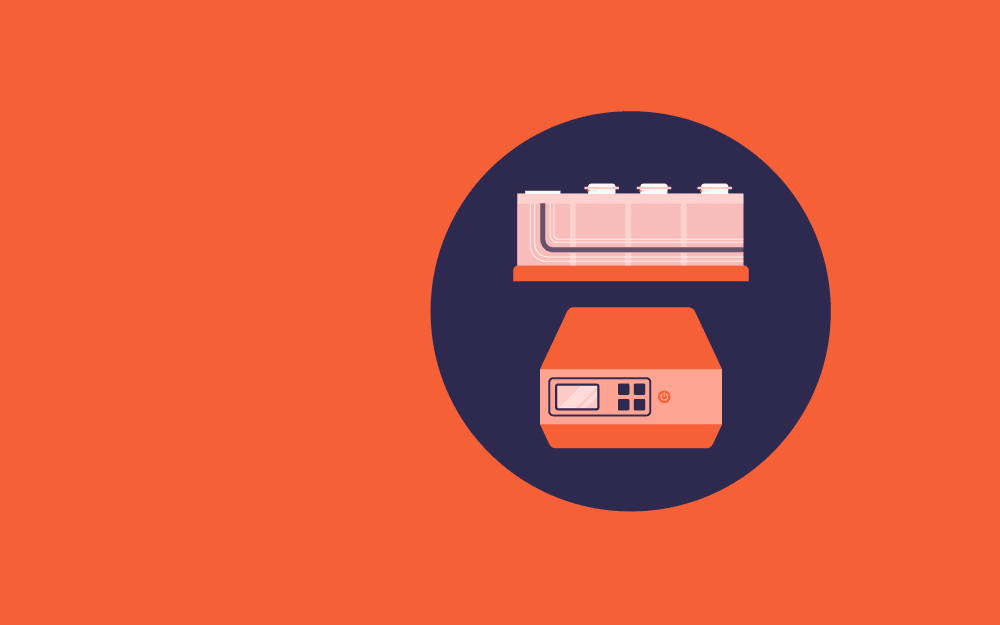
Today, we all — biologists or not — have an idea about how the brain functions. The advanced techniques and lab procedures have made the knowledge accessible and unlocked many mysteries related to brain functioning.
One such procedure is brain slicing. It’s a process in which parts of the brain are divided using advanced technologies or microtomes in desired plane or orientation.
The process helps scientists to understand the underlying pathophysiological conditions of the brain, its development, and its responses to several stimuli. By using a brain slice in controlled physiological conditions, you can study a synapse or neural circuit in isolation from the rest of the brain.[1]
Furthermore, as the brain slice retains the brain’s 3D structural integrity, one can examine the electrophysiological consequences of drug toxicity.[2]
During the process, the brain is sliced using a tissue slicer. Then, to stimulate the particular brain area and record data, the slice is immersed in artificial cerebrospinal fluid (aCSF).[2]
This article is an exposé on brain slicing, including the directions and planes of slicing, equipment used in the procedure, and the applications of the technique.
Before moving to the directions and orientation of brain slice preparation, have a look at some directional terms. These directions also represent the possible views of different parts of the brain during studies.[3]
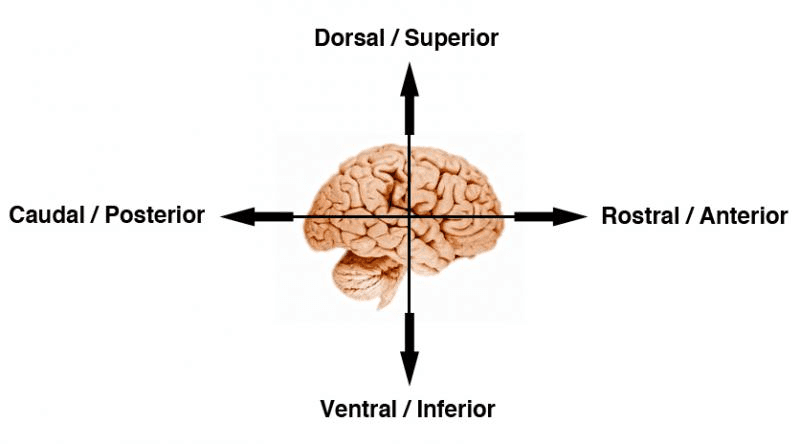
Figure: A schematic diagram of different regions of the brain and their scientific terms.[3]
Furthermore, a 3-dimensional brain has three planes, which also represent the ways a brain can be sectioned for experimental procedures:
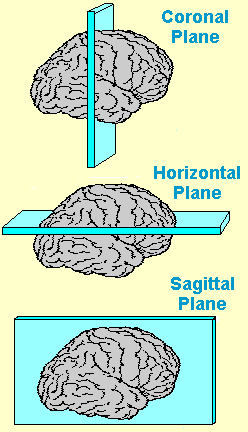
Figure: An illustrative diagram of different planes of the brain.[5]
Brain slice preparation is a high-throughput procedure that requires expertise and knowledge of the equipment, tools, and chemicals to precisely perform the procedure based on experiential requirements.[6]
The Compresstome VF-200 slicing machine is the commonly used slicer in a range of life sciences labs to prepare brain slices including:[6]
The machine uses agarose embedding of the tissue and slight compression to make fine and uniform tissue slices.
Other than the Compresstome VF-200 slicing machine, you also need the following equipment and tools to perform the brain slice procedure:[6]
These are used to house or culture brain slices.[6] It’s of different types, which include:[7]
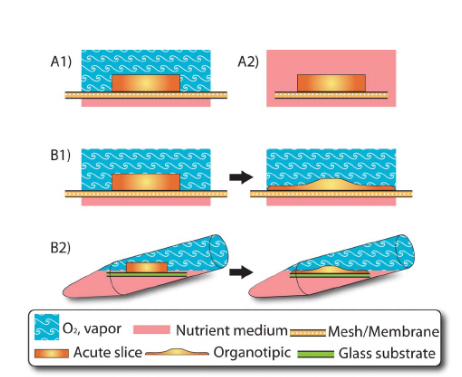
Figure: An illustration of different types of brain slice chambers: (A1) Interface chamber; (A2) submerged slice chamber; (B1) Organotypic slice chambers with interface chamber; and (B2) Organotypic slice chambers in a rotary tube.[7]
Besides these conventional slice chambers, advanced microfluidic devices are also available that provide improved oxygen penetration efficiency and enhance brain slice viability and functions.[7]
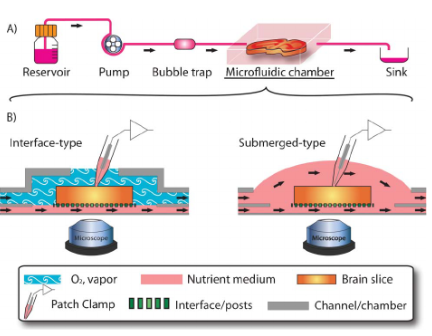
Figure: An illustration of a microfluidic device: (A) integrated into the linear experimental set-up; and (B) combined with conventional slice chambers.[7]
A range of blades are available in the market based on the materials used to manufacture them, such as highly-durable stainless steel, carbon steel feather blades, and ceramic blades.
It includes tools such as fine dissecting “supercut” scissors (for cutting through the skull), fine spatula, heavy-duty spatula, curved blunt forceps, scissors for decapitation, scalpel handle, and 10-number blades.
It includes a large dish filled with Sylgard for pinning anesthetized animals, a 30 mL syringe with 25 5/8 gauge needles, and dissecting pins.
The incubation chamber includes Brain Slice Keeper-4 or any other similar machine. However, it must have a fine gas diffuser stone for infusion of carbogen into the aCSF, a submerged netting for the slices to rest on, and some gentle constant flow to circulate the solution through the slice.
It should be calibrated frequently when in use and the thermocouple should be kept clean.[6]
It should be accompanied by a thermoblock and the temperature should be set at 42°C with the mixing speed at 600 rpm – this maintains the molten state of 1.5% low agarose before usage.[6]
It should always be calibrated before use.
Other than these, others include a carbonate supply machine, electrophysiology rig, blue laser for ChR2 photostimulation experiments, and laser scanning confocal microscope.[6]
Brain slice preparation and usage have several advantages over other conventional techniques, which also increased the implementation of the technique in some experimental studies, such as investigating mammalian CNS activity.
However, some limitations also need to be considered before applying the brain slice preparation and procedure in your lab protocol.
Related Read: Preservation Techniques: Methods for Preserving Tissue Slices
A brain slice is a result of sectioning a particular part of the brain in a specific plane or orientation using a sharp blade. The prepared slice allows us to study underlying pathophysiological conditions, a particular area of the brain and its neural circuitry, and the development of brain tissues and neural networks.
However, there’s a need to develop and introduce affordable technologies that are not labor and time-intensive, and most importantly, do not alter the properties of the tissues to obtain accurate and reliable data.
Though microfluidic technology has the potential to improve brain and neuronal studies, it requires further research to determine its effective applications in that area.
Are you looking for a tissue slice chamber that works in both submerged and interface modes? Check out our acrylic biochemistry dual-channel system.
In behavioral neuroscience, the Open Field Test (OFT) remains one of the most widely used assays to evaluate rodent models of affect, cognition, and motivation. It provides a non-invasive framework for examining how animals respond to novelty, stress, and pharmacological or environmental manipulations. Among the test’s core metrics, the percentage of time spent in the center zone offers a uniquely normalized and sensitive measure of an animal’s emotional reactivity and willingness to engage with a potentially risky environment.
This metric is calculated as the proportion of time spent in the central area of the arena—typically the inner 25%—relative to the entire session duration. By normalizing this value, researchers gain a behaviorally informative variable that is resilient to fluctuations in session length or overall movement levels. This makes it especially valuable in comparative analyses, longitudinal monitoring, and cross-model validation.
Unlike raw center duration, which can be affected by trial design inconsistencies, the percentage-based measure enables clearer comparisons across animals, treatments, and conditions. It plays a key role in identifying trait anxiety, avoidance behavior, risk-taking tendencies, and environmental adaptation, making it indispensable in both basic and translational research contexts.
Whereas simple center duration provides absolute time, the percentage-based metric introduces greater interpretability and reproducibility, especially when comparing different animal models, treatment conditions, or experimental setups. It is particularly effective for quantifying avoidance behaviors, risk assessment strategies, and trait anxiety profiles in both acute and longitudinal designs.
This metric reflects the relative amount of time an animal chooses to spend in the open, exposed portion of the arena—typically defined as the inner 25% of a square or circular enclosure. Because rodents innately prefer the periphery (thigmotaxis), time in the center is inversely associated with anxiety-like behavior. As such, this percentage is considered a sensitive, normalized index of:
Critically, because this metric is normalized by session duration, it accommodates variability in activity levels or testing conditions. This makes it especially suitable for comparing across individuals, treatment groups, or timepoints in longitudinal studies.
A high percentage of center time indicates reduced anxiety, increased novelty-seeking, or pharmacological modulation (e.g., anxiolysis). Conversely, a low percentage suggests emotional inhibition, behavioral avoidance, or contextual hypervigilance. reduced anxiety, increased novelty-seeking, or pharmacological modulation (e.g., anxiolysis). Conversely, a low percentage suggests emotional inhibition, behavioral avoidance, or contextual hypervigilance.
The percentage of center time is one of the most direct, unconditioned readouts of anxiety-like behavior in rodents. It is frequently reduced in models of PTSD, chronic stress, or early-life adversity, where animals exhibit persistent avoidance of the center due to heightened emotional reactivity. This metric can also distinguish between acute anxiety responses and enduring trait anxiety, especially in longitudinal or developmental studies. Its normalized nature makes it ideal for comparing across cohorts with variable locomotor profiles, helping researchers detect true affective changes rather than activity-based confounds.
Rodents that spend more time in the center zone typically exhibit broader and more flexible exploration strategies. This behavior reflects not only reduced anxiety but also cognitive engagement and environmental curiosity. High center percentage is associated with robust spatial learning, attentional scanning, and memory encoding functions, supported by coordinated activation in the prefrontal cortex, hippocampus, and basal forebrain. In contrast, reduced center engagement may signal spatial rigidity, attentional narrowing, or cognitive withdrawal, particularly in models of neurodegeneration or aging.
The open field test remains one of the most widely accepted platforms for testing anxiolytic and psychotropic drugs. The percentage of center time reliably increases following administration of anxiolytic agents such as benzodiazepines, SSRIs, and GABA-A receptor agonists. This metric serves as a sensitive and reproducible endpoint in preclinical dose-finding studies, mechanistic pharmacology, and compound screening pipelines. It also aids in differentiating true anxiolytic effects from sedation or motor suppression by integrating with other behavioral parameters like distance traveled and entry count (Prut & Belzung, 2003).
Sex-based differences in emotional regulation often manifest in open field behavior, with female rodents generally exhibiting higher variability in center zone metrics due to hormonal cycling. For example, estrogen has been shown to facilitate exploratory behavior and increase center occupancy, while progesterone and stress-induced corticosterone often reduce it. Studies involving gonadectomy, hormone replacement, or sex-specific genetic knockouts use this metric to quantify the impact of endocrine factors on anxiety and exploratory behavior. As such, it remains a vital tool for dissecting sex-dependent neurobehavioral dynamics.
The percentage of center time is one of the most direct, unconditioned readouts of anxiety-like behavior in rodents. It is frequently reduced in models of PTSD, chronic stress, or early-life adversity. Because it is normalized, this metric is especially helpful for distinguishing between genuine avoidance and low general activity.
Environmental Control: Uniformity in environmental conditions is essential. Lighting should be evenly diffused to avoid shadow bias, and noise should be minimized to prevent stress-induced variability. The arena must be cleaned between trials using odor-neutral solutions to eliminate scent trails or pheromone cues that may affect zone preference. Any variation in these conditions can introduce systematic bias in center zone behavior. Use consistent definitions of the center zone (commonly 25% of total area) to allow valid comparisons. Software-based segmentation enhances spatial precision.
Evaluating how center time evolves across the duration of a session—divided into early, middle, and late thirds—provides insight into behavioral transitions and adaptive responses. Animals may begin by avoiding the center, only to gradually increase center time as they habituate to the environment. Conversely, persistently low center time across the session can signal prolonged anxiety, fear generalization, or a trait-like avoidance phenotype.
To validate the significance of center time percentage, it should be examined alongside results from other anxiety-related tests such as the Elevated Plus Maze, Light-Dark Box, or Novelty Suppressed Feeding. Concordance across paradigms supports the reliability of center time as a trait marker, while discordance may indicate task-specific reactivity or behavioral dissociation.
When paired with high-resolution scoring of behavioral events such as rearing, grooming, defecation, or immobility, center time offers a richer view of the animal’s internal state. For example, an animal that spends substantial time in the center while grooming may be coping with mild stress, while another that remains immobile in the periphery may be experiencing more severe anxiety. Microstructure analysis aids in decoding the complexity behind spatial behavior.
Animals naturally vary in their exploratory style. By analyzing percentage of center time across subjects, researchers can identify behavioral subgroups—such as consistently bold individuals who frequently explore the center versus cautious animals that remain along the periphery. These classifications can be used to examine predictors of drug response, resilience to stress, or vulnerability to neuropsychiatric disorders.
In studies with large cohorts or multiple behavioral variables, machine learning techniques such as hierarchical clustering or principal component analysis can incorporate center time percentage to discover novel phenotypic groupings. These data-driven approaches help uncover latent dimensions of behavior that may not be visible through univariate analyses alone.
Total locomotion helps contextualize center time. Low percentage values in animals with minimal movement may reflect sedation or fatigue, while similar values in high-mobility subjects suggest deliberate avoidance. This metric helps distinguish emotional versus motor causes of low center engagement.
This measure indicates how often the animal initiates exploration of the center zone. When combined with percentage of time, it differentiates between frequent but brief visits (indicative of anxiety or impulsivity) versus fewer but sustained center engagements (suggesting comfort and behavioral confidence).
The delay before the first center entry reflects initial threat appraisal. Longer latencies may be associated with heightened fear or low motivation, while shorter latencies are typically linked to exploratory drive or low anxiety.
Time spent hugging the walls offers a spatial counterbalance to center metrics. High thigmotaxis and low center time jointly support an interpretation of strong avoidance behavior. This inverse relationship helps triangulate affective and motivational states.
By expressing center zone activity as a proportion of total trial time, researchers gain a metric that is resistant to session variability and more readily comparable across time, treatment, and model conditions. This normalized measure enhances reproducibility and statistical power, particularly in multi-cohort or cross-laboratory designs.
For experimental designs aimed at assessing anxiety, exploratory strategy, or affective state, the percentage of time spent in the center offers one of the most robust and interpretable measures available in the Open Field Test.
Written by researchers, for researchers — powered by Conduct Science.








Monday – Friday
9 AM – 5 PM EST
DISCLAIMER: ConductScience and affiliate products are NOT designed for human consumption, testing, or clinical utilization. They are designed for pre-clinical utilization only. Customers purchasing apparatus for the purposes of scientific research or veterinary care affirm adherence to applicable regulatory bodies for the country in which their research or care is conducted.